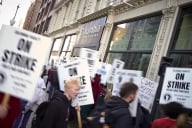You have /5 articles left.
Sign up for a free account or log in.
It’s rare for an M.B.A. program -- where after all there are pricing experts on the faculty -- to admit that it’s charging too much.
But that’s exactly the case with the University of Rochester’s Simon Business School, which next year plans to reduce the tuition for the entire two years of the M.B.A. from about $106,500 to $92,000.
The 14 percent tuition reduction is a course correction for Rochester, which is charging more than most universities with similar rankings and test score averages. Its high sticker price causes prospective students to rule out Rochester early on in their search process, fears Andrew Ainslie, dean of the business school.
Rochester and most high-quality business schools certainly give out aid, but unlike undergraduate programs that announce deep tuition cuts from rates that hardly anyone pays, M.B.A. programs assume many students do pay sticker price (in some cases by borrowing).
Ainslie notes that there’s a correlation between price and ranking, and Rochester -- which ranks No. 37 among M.B.A. programs by U.S. News & World Report and No. 38 by Bloomberg Businessweek -- didn’t fit within that curve. Rochester has increased tuition between 3 to 5 percent year after year, without really considering the impact the increases were having on its cost relative to its peers (Rochester's tuition increased from $72,700 in fall 2006 to $106,500 this fall).
“The higher ranked the school is, the higher the price. And the lower ranked the school is, the lower the price. So we were a bit of an outlier,” he said. “We sort of looked at it as an economic problem.”
The University of Pennsylvania, Stanford University and the University of Chicago each charge more than $120,000 for M.B.A. tuition, but their programs are also ranked among the top five in the country by Businessweek. Meanwhile the University of Washington and the University of Buffalo, which have M.B.A. programs ranked just above and below Rochester, price their M.B.A. tuition at $61,000 and $34,000, respectively.
Rochester gives out about $5 million in scholarship funding each year (Ainslie declined to say what percentage of scholarships are of gross tuition). Yet while tuition figures are publicly available, scholarship figures are more opaque and prospective students usually have little knowledge of what opportunities are available. The result is a pricing structure that lacks transparency, Ainslie said.
The new model will put some of the existing scholarship funding toward lowering tuition. Ainslie likened the move to a $14,500 scholarship for all students, and said that it’s a revenue-neutral change for the institution. He says Rochester plans to maintain a generous scholarship program, which is largely based on applicants’ academic competitiveness.
When choosing a business school, applicants typically look at which ones accept test scores within their range and then, within that subset of programs, apply to the best-ranked and lowest-priced options. Because of Rochester’s high sticker price, prospective students were eliminating it early on in their application process.
“What they want is to get in a highly ranked, low-price school that’s appropriate for their GMAT [Graduate Management Admissions Test],” Ainslie said. “If our price is a little out of line … they’re not even going to that second stage.”
A 2015 Graduate Management Admissions Council (GMAC) survey found that financial issues are among the most prominent reservations among prospective students: 48 percent of those surveyed reported attending business school requires more money than they have available and 44 percent said they were hesitant about taking on a large financial debt.
Dan LeClair, chief operating officer of the Association to Advance Collegiate Schools of Business, says transparency and price are of increasing concern for students and institutions alike. Students, he said, want to know “the price that they’ll actually be paying and what kinds of scholarship opportunities are available.” Meanwhile, institutions are realizing there’s a ceiling on what students are willing to pay.
“There's a general awareness in our industry that prices can't keep going up and up and up without some impact on demand,” he said.
It will take time for the change at Rochester to significantly impact enrollment, but Ainslie is expecting a larger first-year class in 2017. Rochester’s M.B.A. program is relatively modest in size: enrollment last year was 213 full-time students.
“I am very optimistic that we are going to have quite a big uptick, something in excess of 20 percent in 2017,” he said.
As Rochester adjusts its price point, it’s also adjusting its competitiveness in terms of GMAT scores. Ainslie said the institution has intentionally brought its average GMAT score down from 680 to 665 in order to place more emphasis on an applicant’s work experience.
The new pricing strategy is in part a response to softer enrollment from U.S. applicants, a trend that exists throughout M.B.A. programs as business schools begin to offer less-costly and quicker alternatives to two-year, full-time M.B.A.s. Business schools are offering one-year specialized master's programs and other traditional M.B.A. alternatives with increasing frequency.
Stanford University organization theory professor Jeffrey Pfeffer notes that there are some 13,000 M.B.A. programs worldwide and says the industry is over capacity. Coupled with the increase in online education and one-year programs, he believes that “at some point … tuition is going to collapse.”
“Everyone I know expects a substantial shakeout in the M.B.A. industry,” he wrote in an email, saying that such a collapse is “long overdue.”
In 2014, an application trends survey by GMAC found that 62 percent of surveyed M.B.A. programs in the U.S. saw a rise in applications. Yet the increased interest was largely from international students. Fewer than half of surveyed M.B.A. programs, or 48 percent, reported increased interest among domestic applicants.
“American applicants, those numbers have dropped and dropped,” Ainslie said, though he maintains that demand for employees with M.B.A.s remains high.
“Industry really wants us to keep producing M.B.A. students, but we seem to be getting less and less interest from potential students,” he continued. “That's where the battle occurs and that's where we have to make very sure that we stay competitive.”








